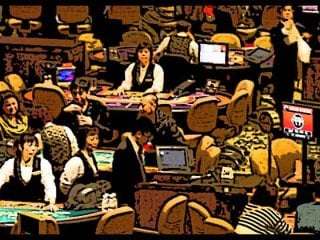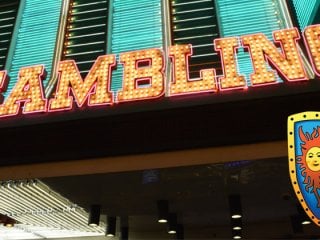How Do Casinos Make Money from Poker?
By Alex Smith, Last updated May 29, 2024

Casinos have long been a popular destination for those seeking entertainment, excitement, and the potential to win big. While you may associate most casinos with offering casino table games and video slots, you’d be surprised to learn that a lot now offer poker – and that’s not just because they’re kind: it generates good money for them!
In this comprehensive blog post, we’ll explore how casinos profit from poker, from collecting rake (including the maximum rake and capped rake) to how a tournament buy-in works and more. Later, we’ll discuss the online poker world and how it generates revenue, too!
The Basics of Poker Games in Casinos
Before we can explore how casinos make money from the poker table – and, later, how the online poker industry works – it’s essential to have a solid grasp of how the game is played in brick-and-mortar casinos. Poker, famed for being a gambling game that isn’t just luck, combines skill and strategy too. While there are numerous variations of the game, it’s Texas Hold’em that’s the most popular – by far.
At the Texas Hold’em poker table, each player is dealt two private cards, known as hole cards. These cards are for the player’s eyes only and form the foundation of their hand. After the hole cards are dealt, five community cards are placed face-up on the table and shared by all players. The objective is to create the best possible five-card hand using any combination of the seven available cards (two hole cards plus five community cards).
One of the unique aspects of poker in casinos is that players compete against each other, not against the house. This separates poker from other casino games like blackjack or roulette, where players bet against the casino itself. The casino’s role in poker is to facilitate the game, provide a venue, and ensure fair play – not to play against the player.
However, just because the casino isn’t directly involved in the outcome of each hand doesn’t mean they don’t have a financial stake in the game! On the contrary – whether they’re running cash game tables or tournaments, casinos have developed numerous ways to generate revenue from poker, which we’ll explore in detail below.
Making Money In Cash Games: The Rake
The primary way casinos profit from poker is through the rake. The rake is essentially a commission the casino charges for hosting the game. It’s a small percentage of the pot (the total amount of money bet during a single hand) that the casino takes as a fee of sorts. Now, the size of the rake varies depending on the casino and the stakes of the game, but it typically ranges from 2.5% to 10% of the pot.
To demonstrate how the rake works, let’s consider a hypothetical hand of Texas Hold’em with a pot of $100. If the casino’s rake is 5%, they will take $5 from the pot, with the remaining $95 paid to the winning players. The dealer collects the rake before awarding the pot to the winning player.
While 5% might seem small, it’s important to remember that the rake is collected on every single hand. Over a day, a week, or a month, these small percentages can add up to a significant amount of revenue for the casino. In fact, poker rake is why so many casinos are happy to run tables; they make money on poker!
In fact, casinos make money on poker no matter whether you’re playing in an online poker room – and paying rake each hand – or are playing in a tournament, thus paying a fixed fee – or, as it’s also known, an entry fee. Later on, we’ll look at how poker rake works in tournaments – and how casinos make money on poker in other ways!
It’s also worth noting that the rake isn’t the only way casinos can collect a commission from poker games. Some casinos charge players a time fee or a seat charge instead of taking a percentage of the pot. These alternative fee structures will be discussed in more detail later in this post.
Now, one thing is worth mentioning. If professional poker players, for example, are playing at high stakes – the 5% dead drop rake could very quickly become very costly. This is why, at some high-stakes poker tables, players will pay fixed fees to the casino or a fixed percentage rake. The house fee is still very large – due to the stake involved – but players don’t have to worry about their cash game profits being eaten into by hefty rake fees.
How Poker Rooms Take Rake
Now, whether you play poker games in online poker rooms or play poker cash games at land-based casinos, the method of taking rake is usually similar – assuming no fixed fees are being used. In live games and at the best poker sites, the method of taking pot rake should be clearly explained to you – and if, at any time during the poker game, you want to know more – that information should be readily available to you.
One of the most common rake structures is the pot rake, which we discussed in the previous section. With a pot rake, the casino takes a percentage of the total pot, typically ranging from 2.5% to 10%. This structure is often used in low-stakes games and is generally considered the most straightforward and transparent method of collecting the rake.
Another common structure is fixed fees – also known as fixed rake – where the casino takes a set amount from each pot, regardless of size. For example, the casino may collect $1 from every pot, whether it’s a $10 pot or a $1,000 pot. This structure is more common in higher-stakes games, where the rake percentage would be too small to generate significant revenue for the casino.
Some casinos also use a time collection method, where players pay a set fee per hour or half-hour to play at the table. This fee is collected regardless of the number of hands played or the size of the pots. Time collection is often used in high-stakes games or games with a limited number of players, as it ensures that the casino generates a steady revenue stream even if the pots are small or the action is slow.
It should go without saying that the rake structure used by a casino can have a significant impact on the profitability of the game for both the casino and the players. As a result, poker halls and casinos need to be careful with the rake percentage they set.
If the rake is too high, players may simply not sit down at the poker table – as they may feel any potential profits are going to be eaten into too much. On the other hand, if the rake is too low, the casino may not generate enough revenue to cover its costs. After all, live games aren’t cheap to run!
Poker Tournaments: A Different Revenue Model
While cash games are the bread and butter of casino poker, tournaments are also incredibly popular – and they offer casinos a different way to generate revenue. In a poker tournament, players pay a fixed buy-in and receive a set number of chips. They play until they either lose all their chips or win all the chips in play. The casino takes a percentage of the total buy-ins as a “fee” for hosting – and running – the tournament, and this is known as the entry fee or tournament rake.
For example, let’s consider a tournament with a $100 buy-in and a $10 entry fee. Each player pays $110 to participate, with $100 going towards the prize pool and $10 going to the casino. If 100 players enter the tournament, the total prize pool would be $10,000 (100 x $100), and the casino would collect $1,000 (100 x $10) in entry fees.
Tournaments can be an attractive option for casinos for several reasons. First, they generate more upfront revenue, as the casino collects all the entry fees before the tournament begins. This is very different from cash games, where the casino’s revenue is spread out over many hands and dependent on the size of the pots. (Unless, of course, the casino uses a fixed fee or time-collection method.)
Secondly, tournaments can attract more players due to the potential for large prize pools. Even tournaments with 40 or 50 players can see prize pools reaching into the tens of thousands of dollars – and, naturally, the larger a prize pool gets, the more interest there is from players – and the more entries are likely to come!
Finally, tournaments offer casinos a way to generate buzz and excitement around their poker offerings. Major tournaments like the World Series of Poker, where professional poker players frequent, or big poker rooms running exclusive tournaments and poker tables can generate huge interest. In fact, some of the biggest online games, and even live cash game tables, are streamed (with a slight delay) online – often attracting millions of viewers!
Of course, running successful poker tournaments requires a significant investment from the casino, too. They need to be able to provide excellent service to all players. they must provide qualified staff, and ensure that the tournament is run smoothly and fairly!
How Else Do Poker Rooms Make Money?
While rake and tournament fees are the main ways casinos generate revenue from poker, they are far from being the only income sources. Casinos also indirectly generate money from poker by selling food, drinks, and other amenities – and, of course, will want players to gamble in the casino, too.
Poker players often spend long hours at the table, and casinos have learned to capitalize on this by offering a range of services designed to keep players comfortable and engaged. By providing a more enjoyable and convenient experience, casinos can encourage players to stay longer and play more, which in turn generates more revenue. Let’s look at some additional ways casinos make money from poker.
Food and Drinks
One of the most common poker room amenities is food and drinks service. Many casinos offer tableside dining, allowing players to order meals and refreshments without having to leave the table. This not only provides a convenient service for players but also generates additional revenue for the casino through the sale of food and drinks.
Exclusive Memberships
Casinos may also offer exclusive poker room memberships, which provide players with access to special events, discounts, and other perks. These memberships often come with a fee, creating another revenue stream for the casino. In addition to generating direct revenue, memberships can also be very beneficial for land-based casinos and poker rooms, as it allows them to promote upcoming events.
Merchandise
Another way casinos profit from poker is through the sale of merchandise. Many casinos sell branded poker chips, cards, clothing, and other accessories. While you typically don’t see any merchandise for sale at your local land-based casino, if you go to major tournaments – like the WSOP – you’ll see a lot of merchandise – and it’s a surprisingly good money maker for the casino!
Poker Lessons and Coaching
Some casinos also offer poker lessons and coaching services, providing players with an opportunity to improve their skills and learn from experienced professionals. These services typically come with a fee, generating yet another source of revenue for the casino. We’ve also seen some poker rooms partnering with well known professionals.
Basically, live poker rooms are designed to be as comfortable as possible. The casinos design poker rooms so that players can stay seated and comfortable for as long as possible without leaving the table. Some land-based casinos even offer masseuses for tournaments!
How Online Poker Rooms Make Money
In the world of online poker, the methods used by poker sites to generate revenue are similar to those employed by brick-and-mortar casinos. However, there are some unique factors to consider when it comes to how online casinos and poker rooms make money from poker games.
We’ll discuss some of the most common revenue generation methods below.
Rake in Online Poker
Just like in live poker cash games, online poker sites collect a rake from each pot. The rake amount is typically a percentage of the pot, ranging from 2.5% to 5%, with a maximum cap to limit the rake in poker. For example, a poker site might take a 5% rake from each cash game pot up to a maximum of $3.
One advantage of playing poker online is that the rake in poker is often lower compared to live games. This is because online poker rooms have lower overhead costs, as they don’t need to maintain a physical venue or hire as many employees. Lower online poker rake means that poker players can potentially enjoy better long-term profits – although variance can be much higher online, due to the larger number of hands played.
Tournament Fees and Deposit Fees
In addition to collecting rake-in poker cash games, online poker sites also make money through tournament fees. When a poker player enters an online tournament, a portion of their buy-in goes towards the prize pool, while the remaining amount is a tournament fee that the poker site keeps as revenue.
Some online casinos and poker rooms also charge deposit fees when players add funds to their accounts. These deposit fees can vary depending on the payment method used and the poker site’s policies. While not all poker sites charge deposit fees, it’s another way for them to generate revenue.
It’s also worth noting that in some jurisdictions, charging deposit fees is prohibited. The United Kingdom Gambling Commission (UKGC) was one of the first regulators to bring in this rule – and it means online gambling sites who’d been relying on it, had to find other means of increasing revenue!
Rakeback and Other Promotions
To attract and keep poker players, many online poker sites offer rakeback bonuses and other promotions. Rakeback refers to a percentage of the rake and tournament fees that are returned to the player as a reward for their loyalty. Some poker rooms also offer rake-free promotions, where players can enjoy poker games without paying any rake for a limited time!
Conclusion
As you can now see, rake in poker isn’t complicated. Whether you’re playing your favorite poker game online or heading down to your local land-based casino, you should now have a much clearer understanding of how rake in poker works – and how it’s taken from pots.
For players, understanding how the rake in poker is calculated is very important. It allows you to get an idea of whether the rake is too high – and this gives you added flexibility to choose where you want to play.
After all, by being aware of the different rake structures, tournament fees, and other costs associated with the game, players can choose the games that offer the best value and the greatest potential for profit!
FAQs
How much rake do casinos typically take from cash game pots?
Casinos usually take between 2.5% and 10% of each cash game pot as rake, with the exact percentage varying based on the stakes and the specific casino. For example, a casino might take a 5% rake capped at $5 from a $1/$2 No Limit Hold’em game.
Is the rake lower in online poker compared to live games?
Online poker sites often have lower rake compared to brick-and-mortar casinos due to lower overhead costs. While a live casino might take a 10% rake, an online poker room could take just 5% or less. This allows online players to enjoy better long-term profits potentially.
How do poker tournaments generate revenue for casinos?
Casinos make money from poker tournaments by charging entry fees or taking a percentage of each buy-in. For instance, a $100 tournament might have a $10 entry fee, meaning the casino keeps $10 from each player who enters, while the rest goes into the prize pool.
Do all online poker sites charge deposit fees?
Not all online poker rooms charge deposit fees, but some do depending on the payment method and the site’s policies. However, in some jurisdictions like the United Kingdom, charging deposit fees is prohibited by gambling regulators to protect players from unfair charges.
What is rakeback in online poker, and how does it work?
Rakeback is a loyalty program offered by some online poker sites where a percentage of the rake and tournament fees paid by a player are returned to them as a reward. This incentivizes players to continue playing on the site and can help boost their overall profits.
Can poker rooms make money from sources other than rake and entry fees?
Yes, poker rooms have various additional revenue streams beyond just collecting rake and entry fees. These include selling food and drinks to players at the tables, offering exclusive memberships and merchandise, providing poker lessons and coaching services, and more.
What factors should players consider when choosing a poker room?
When deciding where to play poker, players need to compare the rake structures, tournament fees, and other costs associated with different venues or sites. By seeking out the most player-friendly games, individuals can improve their odds of coming out ahead in the long run.
How do casino poker rooms keep players comfortable during long sessions?
To encourage extended play, casino poker rooms offer various amenities to keep guests satisfied. Tableside dining allows players to enjoy meals without stepping away from the action, while massage services help relieve strain!
Related Articles you Should Read
How Many Hands Per Hour: Live Poker Explained
In this blog post, we’ll dive into the factors influencing the number of hands dealt per hour in live poker.
How Does a Casino Make Money on Poker?
It will come as no surprise to learn that online poker sites and online casinos are in the business of making money; that’s their ultimate goal, and while many of these sites may offer attractive – and lucrative – bonuses and promotions designed to temp in new players, the ultimate goal is to generate as much revenue as possible.
How to Play Slow Roll Poker
The goal of poker is to beat your opponent; in fact, doing so is actively encouraged! However, while you should always try your best to throw your opponents off-balance and coerce them to make mistakes
What is the Dead Man’s Hand in Poker?
The deadman’s hand is one of the most iconic hands in poker. While some players have slightly different definitions of the dead man’s hand, most people regard it as a hand containing two Aces and two Eights – equalling two pairs. However, while the hand may look quite simple, there is much more to meet the eye.
What Happened to Mike Matusow
If you’re wondering what’s actually happened to Mike Matusow – and want to know what this colorful character is up to these days – keep reading to find out what this star poker player is up to these days!








